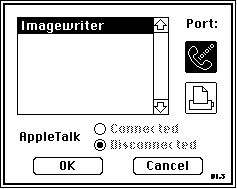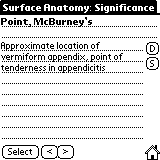

Monochromatic software
For its first six versions, Apple's Macintosh operating system was monochromatic. Though color Macintoshes were introduced in 1989, the extra CPU power and display capability needed for color was not applied to the components of the operating system itself until Mac OS System 7 was introduced in May 1991.
In monochrome systems, all grey tones on the screen are simulated with dithering (checkerboarding patterns of "on" and "off" pixels). Highlighting can not be created with color, so reversal (white on black instead of black on white) is used. Components of the interface such as buttons, as well as divisions of the screen area into smaller sections, are usually created with simple outlines, since the use of areas of color is not possible.
These techniques were employed on early multimedia projects distributed on CD-ROM, where the speed of CD-ROM drives as well as the computer itself prevented the widespread use of color graphics. As Manovich notes, today the displays of personal digital assistants, cellular phones, and other portable computing devices use these old methods. The images of Mac OS (top) and PalmOS (bottom) components on the right show an amazing similarity in design techniques -- though they are separated by fifteen years of interface design evolution.
More about early Mac OS systems can be found at The Mac 512 and Mac System 1.0.
Mac OS dialog box from a mirror of an old version of the Apple Museum.
Palm OS screenshot from Palm Pilot Archives.